Imperial Japanese Army General Staff Office
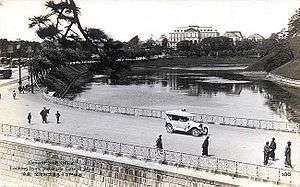
The Imperial Japanese Army General Staff Office (参謀本部 Sanbō Honbu), also called the Army General Staff, was one of the two principal agencies charged with overseeing the Imperial Japanese Army.
Role
The Army Ministry (陸軍省 Rikugunshō) was created in April 1872, along with the Navy Ministry, to replace the Ministry of Military Affairs (Hyōbushō) of the early Meiji government. Initially, the Army Ministry was in charge of both administration and operational command of the Imperial Japanese Army; however, from December 1878, the Imperial Army General Staff Office took over all operational control of the Army, leaving the Army Ministry only with administrative functions. The Imperial Army General Staff was thus responsible for the preparation of war plans; the military training and employment of combined arms; military intelligence; the direction of troop maneuvers; troop deployments; and the compilation of field service military regulations, military histories, and cartography.
The Chief of the Army General Staff was the senior ranking uniformed officer in the Imperial Japanese Army and enjoyed, along with the War Minister, the Navy Minister, and the Chief of the Navy General Staff, direct access to the Emperor. In wartime, the Imperial Army General Staff formed part of the army section of the Imperial General Headquarters, an ad hoc body under the supervision of the emperor created to assist in coordinating overall command.
History
Following the overthrow of the Tokugawa shogunate in 1867 and the "restoration" of direct imperial rule, the leaders of the new Meiji government sought to reduce Japan's vulnerability to Western imperialism by systematically emulating the technological, governing, social, and military practices of the European great powers. Initially, under Ōmura Masujirō and his newly created Ministry of the Military Affairs (Hyōbu-shō), the Japanese military was patterned after that of France. However, the stunning victory of Prussia and the other members of the North German Confederation in the 1870/71 Franco-Prussian War convinced the Meiji oligarchs of the superiority of the Prussian military model and in February 1872, Yamagata Aritomo and Oyama Iwao proposed that the Japanese military be remodeled along Prussian lines. In December 1878, at the urging of Katsura Taro, who had formerly served as a military attaché to Prussia, the Meiji government fully adopted the Prussian/German general staff system (Großer Generalstab) which included the independence of the military from civilian organs of government, thus ensuring that the military would stay above political party maneuvering, and would be loyal directly to the emperor rather than to a Prime Minister who might attempt to usurp the emperor's authority.
The administrative and operational functions of the army were divided between two agencies. A reorganized Ministry of War served as the administrative, supply, and mobilization agency of the army, and an independent Army General Staff had responsibility for strategic planning and command functions. The Chief of the Army General Staff, with direct access to the emperor could operate independently of the civilian government. This complete independence of the military from civilian oversight was codified in the 1889 Meiji Constitution which designated that the Army and Navy were directly under the personal command of the emperor, and not under the civilian leadership or Cabinet.
Yamagata became the first chief of the Army General Staff in 1878. Thanks to Yamagata's influence, the Chief of the Army General Staff became far more powerful than the War Minister. Furthermore, a 1900 imperial ordinance (Military Ministers to be Active-Duty Officers Law (軍部大臣現役武官制 Gumbu daijin gen'eki bukan sei)) decreed that the two service ministers had to be chosen from among the generals or lieutenant generals (admirals or vice admirals) on the active duty roster. By ordering the incumbent War Minister to resign or by ordering generals to refuse an appointment as War Minister, the Chief of the General Staff could effectively force the resignation of the cabinet or forestall the formation of a new one.
Of the seventeen officers who served as Chief of the Army General Staff between 1879 and 1945, three were members of the Imperial Family (Prince Arisugawa Taruhito, Prince Komatsu Akihito, and Prince Kan'in Kotohito) and thus enjoyed great prestige by virtue of their ties to the Emperor.
The American Occupation authorities abolished the Imperial Army General Staff in September 1945.
Organization
The Organization of the Army General Staff Office underwent a number of changes during its history. Immediately before the start of the Pacific War, it was divided into four operational bureaus and a number of supporting organs:
Chief of the Army General Staff (general or Field Marshal)
Vice Chief of the Army General Staff (lieutenant general)
- General Affairs (personnel, accounting, medical, mobilization planning) [1]
- G-1 (Operations)
- Strategy and Tactics Department
- Land Survey Department
- G-2 (Intelligence)
- Russia Department
- Europe and North America Department
- China Department
- Others Department
- G-3 (Transport & Communications)
- G-4 (Historical and Maps) [2]
- G-5 (Fortifications) [from Jan 1889-Dec 1908]
- General Staff College
Chiefs of the Army General Staff
Note: The given rank for each person is the rank the person held at last, not the rank the person held at the time of their post as Chief of the Army General Staff. For example, the rank of Field Marshal existed only in 1872/73 and from 1898 onward.
| No. | Name | Portrait | Rank | Term of Office | |
|---|---|---|---|---|---|
| Start | End | ||||
| 1 | Count Yamagata Aritomo |  |
Field Marshal | 24 December 1878 | 4 September 1882 |
| 2 | Ōyama Iwao |  |
Field Marshal | 4 September 1882 | 13 February 1884 |
| 3 | Marquis Yamagata Aritomo |  |
Field Marshal | 13 February 1884 | 22 December 1885 |
| 4 | Prince Arisugawa Taruhito |  |
General | 22 December 1885 | 14 May 1888 |
| 5 | Ozawa Takeo |  |
Lieutenant General | 14 May 1888 | 9 March 1889 |
| 6 | Prince Arisugawa Taruhito |  |
General | 9 March 1889 | 15 January 1895 |
| 7 | Prince Komatsu Akihito |  |
Field Marshal | 26 January 1895 | 20 January 1898 |
| 8 | Kawakami Soroku | 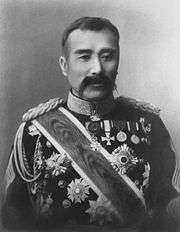 |
General | 20 January 1898 | 11 May 1899 |
| 9 | Prince Ōyama Iwao |  |
Field Marshal | 16 May 1899 | 20 June 1904 |
| 10 | Prince Yamagata Aritomo |  |
Field Marshal | 20 June 1904 | 20 December 1905 |
| 11 | Prince Ōyama Iwao |  |
Field Marshal | 20 December 1905 | 11 April 1906 |
| 12 | Kodama Gentarō |  |
General | 11 April 1906 | 30 July 1906 |
| 13 | Baron Oku Yasukata |  |
Field Marshal | 30 July 1906 | 20 January 1912 |
| 14 | Hasegawa Yoshimichi |  |
Field Marshal | 19 January 1912 | 17 December 1915 |
| 15 | Uehara Yūsaku |  |
Field Marshal | 17 December 1915 | 17 March 1923 |
| 16 | Kawai Misao |  |
General | 17 March 1923 | 2 March 1926 |
| 17 | Suzuki Soroku |  |
General | 2 March 1926 | 19 February 1930 |
| 18 | Kanaya Hanzo |  |
General | 19 February 1930 | 23 December 1931 |
| 19 | Prince Kan'in Kotohito |  |
Field Marshal | 23 December 1931 | 3 October 1940 |
| 20 | Hajime Sugiyama | 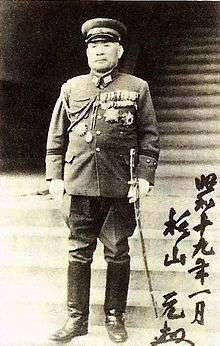 |
Field Marshal | 3 October 1940 | 21 February 1944 |
| 21 | Hideki Tojo | 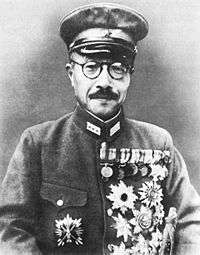 |
General | 21 February 1944 | 18 July 1944 |
| 22 | Yoshijirō Umezu |  |
General | 18 July 1944 | September 1945 |
Vice Chiefs of the Army General Staff
| No. | Name | Portrait | Rank | Term of Office | |
|---|---|---|---|---|---|
| Start | End | ||||
| 1 | Ōyama Iwao |  |
Field Marshal | 5 December 1878 | 16 October 1879 |
| Post vacant (16 October 1879 – 6 February 1882) | |||||
| 2 | Soga Sukenori |  |
Lieutenant General | 6 February 1882 | 21 May 1885 |
| 3 | Kawakami Soroku |  |
General | 21 May 1885 | 16 March 1886 |
| 4 | Soga Sukenori |  |
Lieutenant General | 16 March 1886 | 26 July 1886 |
| 5 | Ozawa Takeo |  |
Lieutenant General | 26 July 1886 | 12 May 1888 |
| Post vacant (12 May 1888 – 9 March 1889) | |||||
| 6 | Kawakami Soroku |  |
General | 9 March 1889 | 20 January 1898 |
| Post vacant (20 January 1898 – 26 August 1898) | |||||
| 7 | Osako Hisatoshi | General | 26 August 1898 | 25 April 1900 | |
| 8 | Terauchi Masatake | 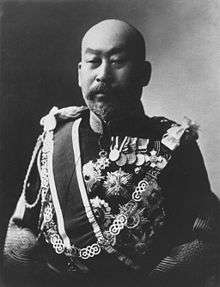 |
Field Marshal | 25 April 1900 | 27 March 1902 |
| 9 | Tamura Iyozu | Major General | 17 April 1902 | 1 October 1903 | |
| 10 | Fukushima Sei | General | 2 October 1903 | 12 October 1903 | |
| 11 | Kodama Gentarō |  |
General | 12 October 1903 | 11 April 1906 |
| 12 | Fukushima Sei | General | 16 April 1906 | 25 April 1912 | |
| 13 | Ōshima Ken'ichi | 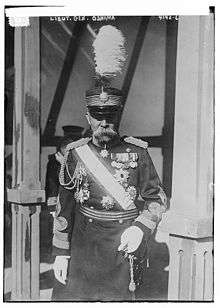 |
Lieutenant General | 25 April 1912 | 17 April 1914 |
| 14 | Akashi Motojiro |  |
General | 17 April 1914 | 4 October 1915 |
| 15 | Tanaka Giichi | 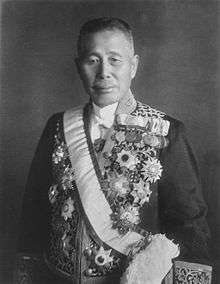 |
General | 4 October 1915 | 10 October 1918 |
| 16 | Fukuda Masataro |  |
General | 10 October 1918 | 5 May 1921 |
| 17 | Kikuchi Shinnosuke | General | 5 May 1921 | 24 November 1922 | |
| 18 | Nobuyoshi Mutō |  |
Field Marshal | 24 November 1922 | 1 May 1925 |
| 19 | Kanaya Hanzo |  |
General | 1 May 1925 | 5 March 1927 |
| 20 | Jirō Minami | 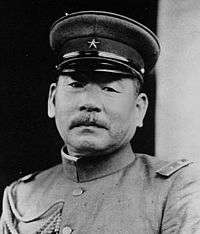 |
General | 5 March 1927 | 1 August 1929 |
| 21 | Okamoto Renichiro | Lieutenant General | 1 August 1929 | 22 December 1930 | |
| 22 | Ninomiya Osamu | Lieutenant General | 22 December 1930 | 9 January 1932 | |
| 23 | Jinzaburō Masaki |  |
Lieutenant General | 9 January 1932 | 19 June 1933 |
| 24 | Kenkichi Ueda | 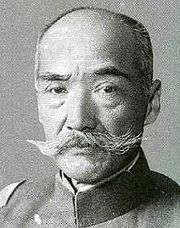 |
General | 19 June 1933 | 1 August 1934 |
| 25 | Hajime Sugiyama |  |
Lieutenant General | 1 August 1934 | 23 March 1936 |
| 26 | Nishio Juzo | General | 23 March 1936 | 1 March 1937 | |
| 27 | Imai Kiyoshi | Lieutenant General | 1 March 1937 | 14 August 1937 | |
| 28 | Hayao Tada |  |
General | 14 August 1937 | 10 December 1938 |
| 29 | Nakajima Tetsuzo | Lieutenant General | 10 December 1938 | 2 October 1939 | |
| 30 | Sawada Shigeru | Lieutenant General | 2 October 1939 | 15 November 1940 | |
| 31 | Tsukada Osamu |  |
General | 15 November 1940 | 6 November 1941 |
| 32 | Moritake Tanabe |  |
Lieutenant General | 6 November 1941 | 8 April 1943 |
| 33 | Hata Hikosaburo | Lieutenant General | 8 April 1943 | 21 February 1944 | |
| 34 | Jun Ushiroku |  |
Lieutenant General | 21 February 1944 | 7 April 1944 |
| 35 | Torashirō Kawabe |  |
Lieutenant General | 7 April 1945 | September 1945 |
References
- U.S. War Department, Handbook of Japanese Military Forces, TM-E 30-480 (1945; Baton Rouge and London: Louisiana State University Press, 1991, reprint).
- Hayashi, Saburo; Cox, Alvin D (1959). Kogun: The Japanese Army in the Pacific War. Quantico, Virginia: The Marine Corps Association.
- Shin'ichi Kitaoka, "Army as Bureaucracy: Japanese Militarism Revisited", Journal of Military History, special issue 57 (October 1993): 67-83.
- Edgerton, Robert B. (1999). Warriors of the Rising Sun: A History of the Japanese Military. Westview Press. ISBN 0-8133-3600-7.
- Harries, Meirion (1994). Soldiers of the Sun: The Rise and Fall of the Imperial Japanese Army. Random House. ISBN 0-679-75303-6.
Notes
- ↑ Post created 16 January 1899. Responsible for general affairs, personnel affairs, accounting, war organization and mobilization planning. Post abolished 15 October 1943 and responsibilities taken over by the General Affairs Section subordinated directly to the Vice Chief of the General Staff.
- ↑ Responsible for cartography, military history matters, translation and archives. Post abolished 15 October 1943 and responsibilities transferred to the Second Bureau
